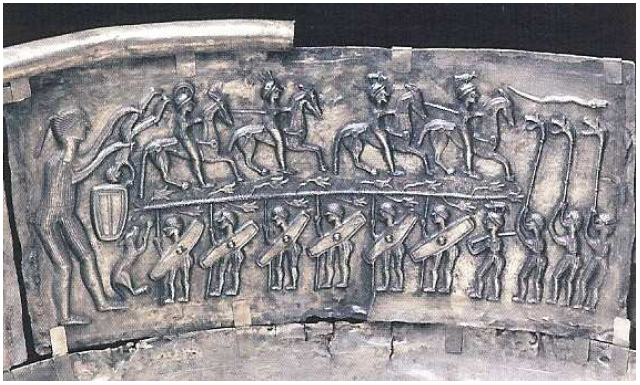3) The Gundestrup Cauldron
This idea of getting intoxicated before battle to be divinely possessed may be illustrated in one of the plaques of the Gundestrup Cauldron (fig. 18),2432 which depicts a scene of warriors, divided into two parts by a vegetal motif - a tree, a pea or a bean. The lower part of the relief* shows a cortège of six soldiers with spears and shields, followed by a warrior holding a sword and wearing a helmet topped with a boar, and by three carnyx* players.2433 These ten warriors are making their way towards a colossal character who is plunging a man, with his two hands, into what seems to be a huge vat. On the upper part of the relief*, four soldiers riding sumptuously-harnessed horses are heading towards the right, possibly following the ram-head snake preceding them. Two of them are wearing helmets bearing a boar and a crow.
Recently, an astronomical interpretation has been proposed for this plaque. It could be the symbolic representation of the two equinoxes, the two solstices and the twelve lunar months (?), or of the passage from autumn to spring.2434 Even though this interpretation is interesting, it is not convincing. It is indeed undeniable that this relief* is a scene depicting the preparation of soldiers heading for a forthcoming battle. The signification of the pre-war scene is nonetheless difficult to determine, especially because of the presence of this huge personage thrusting a man into a vat.
In view of our previous work, a plausible interpretation of this scene seems to be possible. First of all, it is clear that the disproportionate size of the character on the left is indicative of a being of divine origin, i.e. a god or a priest holding the sacred esoteric knowledge. The man he is plunging in the vat is undeniably a soldier, because the latter is wearing the exact same helmet and costume as the other warriors. Furthermore, the ten soldiers are represented, on the lower part, as going towards the huge personage, moving very slowly and even seem to be at a standstill, as though they were queuing, waiting their turn to be thrust into the vat. Unlike this motionless line of soldiers, the riders of the upper part are represented in motion, for their mounts seem to be galloping. It seems that, after being plunged into the vat, the soldiers have become heated and ready to set off for war. The vat could therefore contain the sacred beverage giving access to the divine world. Besides, the vegetal motif, i.e. the sacred tree or stem, separating the two lines of warriors, may mark the frontier between the supernatural and natural world, which would be crossed after ingurgitating the intoxicating drink. This scene could thus be suggestive of the rites of intoxication held before the battle to warm up the soldiers and make contact with the otherworld to require its help and strength.

The goddesses of intoxication, embodiment of the sacred beverage, could thus have represented the ancient cult of achieving force and courage through the absorption of ‘magical’ beverages before going into the fighting. Furthermore, it is interesting to note that faces with protruding and hallucinated eyes are represented on some pieces of carts (see fig. 2). This may also be significant. These faces with spellbinding eyes could depict a state of trance and thus illustrate the effect of ritual intoxication on the warriors when waging war on their foes. It may be that these masks picture some divine figures symbolizing the rites of intoxication in the context of war. The goddesses of intoxication may have helped the tribes in the protection of their territory by giving them moral and physical strength to fight the foes. The intoxicant personified by the goddesses was the means through which divine force could be transmitted to the warriors. By ingesting the drink, the champions symbolically swallowed the goddess, which took possession of them. In this way, the Intoxicating Goddesses would represent this whole framework of complex religious beliefs and rites related to war and intoxication.